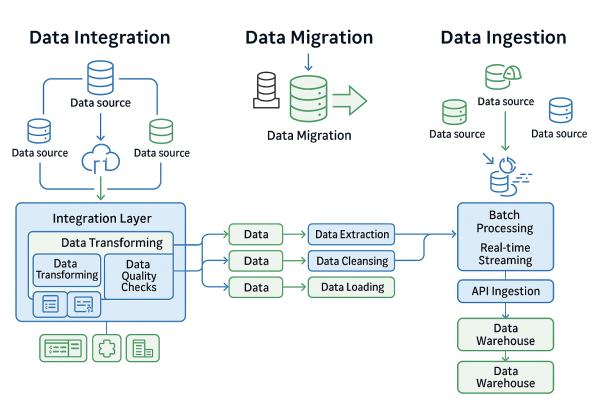Demystifying Data Flows
Explore how data integration, migration, and ingestion work together to build scalable, governed architectures that drive smarter decisions and sustainable growth.
In today’s data-driven world, understanding how information moves and transforms is essential for making better business decisions. Yet, many organisations still blur the lines between three key concepts: data integration, data migration, and data ingestion. Each plays a distinct role, and when used strategically, they can transform data from a challenge into an opportunity.
Key Insights:
- Many organisations still face barriers like data silos, inconsistent standards, and limited frameworks for data sharing
- As AI and analytics adoption accelerate, robust data ingestion pipelines become more critical, but organisations often struggle with schema evolution and data quality
- Data migration projects often face delays and cost overruns due to underestimating complexity, poor planning, and a lack of clear governance.
- Data migration projects frequently run into schedule and budget pressures due to underestimated complexity, limited governance, or poor planning
- Leadership must emphasise data governance, compliance with the Privacy Act 2020, and ethical data use to preserve trust and align with New Zealand’s regulatory environment.
- Skills shortages in data engineering and AI remain a challenge in New Zealand, making investment in talent and cross-functional collaboration essential.
- Architectures that modularise ingestion, integration, and transformation improve agility, scalability, and maintainability of data systems.
- Monitoring, observability, and quality controls are vital to identify data issues early and prevent errors downstream in analytics.
- Enhanced collaboration across government, industry, and academia can help drive shared standards, skills development, and innovation in NZ’s data ecosystem.

Understanding the Three Processes
Data Integration:
Integration brings together data from multiple sources into a single, unified view—supporting more accurate insights and informed decision-making. It’s a continuous process involving discovery, cleansing, transformation, governance, and maintenance.
Data Migration:
Migration is a one-time move: extracting, cleansing, converting, and transferring data from legacy systems to modern platforms. Done well, it consolidates silos and enables organisations to upgrade systems efficiently and securely.
Data Ingestion:
Ingestion is the starting point of any data pipeline. It collects data from diverse origins, applications, devices, or systems; and brings it into a central repository such as a data warehouse or data lake. This can happen in real-time (streaming) or through scheduled batch loads.
Why does this distinction matter?
When approached with the right governance, architecture, and tooling, these elements work together to improve agility, accuracy, and trust across the organisation.
Comparison at a Glance:
Data Integration
-
Combines data from multiple sources into one trusted view
-
Supports ongoing analytics and smarter decisions
-
Continuous process: discovery, cleansing, transformation, and governance
Data Migration
-
Moves data from legacy systems to modern platforms
-
One-time transfer that modernises and consolidates
-
Involves extraction, transformation, loading, and testing
Moving Forward
Mastering integration, migration, and ingestion empowers organisations to connect systems, modernise infrastructure, and make data a strategic asset.
At Circini, we help organisations build practical, governed data strategies that turn complexity into clarity; ensuring your information drives smarter decisions and sustainable growth.
Ready to talk migration or modernisation?
Contact us to start your data transformation journey.